
|
![]()
Greatest Films of the 1940s
1940 | 1941 | 1942 | 1943 | 1944 | 1945 | 1946 | 1947 | 1948 | 1949
Title Screen Film Genre(s), Title, Year, (Country), Length, Director, Description 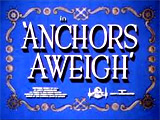

Anchors Aweigh (1945), 143 minutes, D: George Sidney
MGM's Technicolored, Best Picture-nominated lightweight fluffy musical in the post-war years, which headlined a young and thin Frank Sinatra who crooned Julie Styne-Sammy Cahn tunes, and energetic Best Actor-nominated Gene Kelly (his sole Oscar nomination in his career) in a star-making role. It was the stars' first of three film pairings - and similar to Kelly's and Sinatra's later On the Town (1949). The lively musical, with an Oscar-winning Best Musical Score, featured two sailors on a 4-day shore leave from their ship Knoxville in San Diego, and their trip to Los Angeles (Hollywood), looking for love connections: experienced "Pomeranian sailor" and lothario Joseph Brady (Gene Kelly) and the innocent and naive Brooklynite Clarence Doolittle (Frank Sinatra). They met up with aspiring singer Susan Abbott (Kathryn Grayson) who worked as a film extra, and befriended her young 9 year-old runaway nephew Donald Martin (Dean Stockwell in his film debut) who wished to join the Navy. Some of the tunes included Sinatra's "I Fall in Love Too Easily" and "What Makes the Sunset?", and Kelly's live-action magical dance with scene-stealing animated mouse Jerry, the character from MGM's "Tom and Jerry" cartoons, in "The King Who Couldn't Dance (The Worry Song)" number. Susan sang "Jalousie" (or "Jealousy") and "(All of a Sudden) My Heart Sings." In the story, the bashful Clarence fell hard for Susan, and Joe, who was chasing after actress/girlfriend Lola (unseen) at the time, helped him by promising to introduce Susan to MGM music producer and famed orchestra conductor José Iturbi (Himself) - without really knowing him. However, a love triangle developed when Joe also began to have feelings for Susan, while Clarence met a more suitable Brooklyn native match (Pamela Britton in her film debut), a waitress.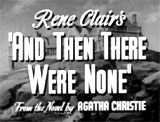



And Then There Were None (1945) (aka Ten Little Niggers, UK), 97 minutes, D: Rene Clair
Agatha Christie's best-selling 1939 detective novel (originally known as Ten Little Niggers) about ten houseguests, and subsequently performed as a stage play, from which this film was developed. This was the best-ever, most entertaining version of the Agatha Christie mystery - the black comedy/mystery story was remade and refilmed numerous times, including George Pollock's Ten Little Indians (1965, UK), Peter Collinson's Ten Little Indians (1974), and Alan Birkinshaw's Ten Little Indians (1989, UK), but this was the original. It served as the basis for the cult satire Murder By Death (1976). Eight individuals, strangers to each other, were invited to a forbidding house on an isolated island off the coast of Devon, England - the mansion was owned by the absent Mr. and Mrs. Owen, but their newly hired servants, butler Thomas (Richard Haydn) and cook Ethel Roberts (Queenie Leonard) were in attendance. Each of the 10, accused of having caused the death of others and escaping punishment, were eliminated. [Note: All of the murders were inspired by the Irish children's nursery rhyme song Ten Little Indians, ("Ten little nigger boys went out to dine; One choked his little self and then there were Nine...").] - the film's sole clue. The mysterious "Mr. U.N. Owen" (read as "Mr. Unknown") had created the remote Indian Island deathtrap. One by one, the guests started dying (off-screen) - by poisoning, drug overdose, stabbing, axing, by a hypodermic needle, a shot to the head, death by a crushing load of bricks, etc. The terminally-ill, wise and retired Judge Francis J. Quinncannon (Barry Fitzgerald), one of the guests, was revealed as the perpetrator of the killings - and identified as the enigmatic Mr. Owen. Quinncannon had faked his own death (bullet hole in the head) with the help of one of the unsuspecting victims, disgraced alcoholic doctor Dr. Edward Armstrong (Walter Huston), who he then killed. At film's end, Quinncannon offered surviving guest Vera Claythorne (June Duprez), a secretary, the option of hanging herself with a noose rather than waiting to be hanged publically. Then, he committed suicide by swallowing poisoned whiskey. Only two guests - who were not guilty of a hidden crime - managed to survive: Vera (who had confessed to a crime committed by her sister - the murder of her fiancee) and dashing adventurer-explorer Philip Lombard (actually his real name was Charles Morley) (Louis Hayward) who had attended in place of his friend Lombard who had committed suicide when threatened by Owen.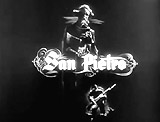

The Battle of San Pietro (1945) (aka San Pietro), 32 minutes, D: John Huston (uncredited)
This was a vivid documentary short from writer/director John Huston, who also served as the uncredited narrator. It was part of executive producer Frank Capra's "Why We Fight" series, but considered anti-war in tone, and the US Army refused to show it in its full footage format of 90 minutes (it was cut down to about 30 minutes). The documentary was a gritty and blunt portrayal of the December 1943 bloody battle of the 5th Army's attack on the small Italian village of San Pietro in the rocky Liri Valley 40 miles SE of Rome - the reality of the fighting was intensified by hand-held cameras. The location was crucial - it blocked Allied forces from advancing forward during an Italian campaign toward Rome. For about two months, there was heavy fighting against the German stronghold in the village, as over 1,100 valiant US soldiers (composed of a team of Texas Rangers and the 143rd Infantry Regiment of the 36th Division) were killed during the conflict. 12 of sixteen supporting tanks were lost in the initial assault, and 1,100 troop replacements were required. Afterwards, Italian peasants were thankful and grateful for being liberated.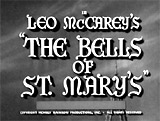


The Bells of St. Mary's (1945), 126 minutes, D: Leo McCarey
A sprightly, entertaining, family-oriented (holiday favorite) and sentimental sequel to Paramount Pictures' Best Picture-winning Going My Way (1944), and a major box-office hit - it ended up being the most profitable picture in the history of RKO Studios. It was the first sequel to be nominated for an Academy Award for Best Picture. Modern-minded priest Father Chuck O'Malley (Oscar-nominated Bing Crosby reprising his earlier Oscar-winning Best Actor performance) was assigned to minister in a parish with a Catholic parochial elementary school attached named St. Mary's. He soon found himself in a good-natured rivalry and conflict with the headstrong Mother Superior, Sister Mary Benedict (Ingrid Bergman). [Note: Her character replaced Barry Fitzgerald's role in the previous 1944 film.] In a series of episodic events, O'Malley helped educate the children with unconventional methods (in contrast to Sister Mary's rules-oriented approach), solved family problems, and improved life for everyone. In one case, they helped teenaged daughter Patricia 'Patsy' Gallagher (Joan Carroll) of single mother Mary Gallagher (Martha Sleeper) reunite with their missing musician-husband-father Joe Gallagher (William Gargan) who walked out on them years earlier. In another scene, Sister Mary taught one of the young boys, Eddie Breen (Richard/Dickie Tyler), to box in order to defend himself against school bullies. The inner-city school was run-down and threatened with being condemned and demolished by a greedy land developer who wanted to build a parking lot. O'Malley partnered with the Mother Superior to raise money for the construction of an addition to the school. They cleverly convinced cranky businessman Horace P. Bogardus (Henry Travers), a rich benefactor to have a change of heart and donate a recently-completed office building next to the school. Along the way, likeable crooner Bing Crosby sang "Adeste Fidelis," "The Bells of St. Mary's," and "O Sanctissma" with a children's choir, and he soloed with "Aren't You Glad You're You," and "In the Land of Beginning Again."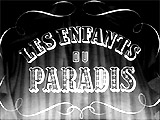



The Children of Paradise (1945, Fr.) (aka Les Enfants Du Paradis), 190 minutes, D: Marcel Carne
Marcel Carne's dazzling and beautiful theatrical masterpiece, a period costume drama, was set in early 19th century Paris in the year 1828. It featured a script by poet and surrealist Jacques Prévert. The epic romantic classic was shot during the period of France's occupation by the Nazis - filmed in secret over an 18-month period. At around $1.5 million, it was the most expensive French film ever made. Its length of over 3 hours, with a tale that spanned several years, required that it be divided into two parts (with two separate sets of credits): Boulevard of Crime and The Man in White. It has often been dubbed "the French Gone With the Wind." The epic story was filled with heartbreaking tragedy, jealous passions and even murder. It told about a beautiful and charismatic courtesan, a raven-haired, fickle, seraphim-like (or Garbo-like luminescence) carnival show performer named Garance (Arletty), aka Claire Reine. She was courted and loved by four very different men during the course of the film: (1) introverted, idealistic, delicate, moon-faced theater mime Baptiste Deburau (Jean-Louis Barrault), (2) pretentious actor and lothario Frédérick Lemaître (Pierre Brasseur), (3) petty thief Pierre-François Lacenaire (Marcel Herrand), and (4) aristocrat nobleman Count Édouard de Montray (Louis Salou). After the opening credits, an actual theatre curtain rose to reveal the first view of the 'children of paradise' (the film's title) - the poor and rowdy playgoers in the audience who must watch from the galleries or balconies at a distance - in the cheap seats. By film's end, criminal Lacenaire assassinated Garance's wealthy and protective Count, while Garance found love in the arms of Baptiste, although he was married to Nathalie (María Casares) (and had fathered a son with her).


Detour (1945), 67 minutes, D: Edgar G. Ulmer
Edgar G. Ulmer's gritty, cheaply-made ("Poverty Row"), fatalistic crime film noir was about the bleak twists of fate. The cultish film was made in only 6 days, and was largely ignored when first released. The film was remade as Detour (1992) and starred the son of the original ill-fated protagonist, Tom Neal, Jr. The flashbacked story was cynically narrated almost non-stop by world-weary Al Roberts (Tom Neal), an East Coast musician. He had been haplessly involved in an ambiguous death in Arizona during his thumbing trek from NY to Los Angeles/Hollywood after ex-bookie turned businessman Charles Haskell (Edmund MacDonald) picked him up. When Haskell suffered an apparent heart attack and fell out of the car (and his head struck a rock), Roberts dumped Haskell's body, stole his car and adopted his identity. Then, after picking up a vulturous, nasty and despicable, yet sexy hitchhiker Vera (Ann Savage), she accused him of not being Haskell ("You're a cheap crook and you killed him"). She turned out to be a blackmailing, vindictive femme fatale con. Roberts commented upon fate and the blackmailing, castrating, exploitative, sadomasochistic and vindictive femme fatale con: "That's life - which ever way you turn, Fate sticks out a foot to trip you up." Vera schemed to turn Roberts in as a murderer, unless he agreed to sell the car and also to claim a substantial inheritance from Haskell's dying father, by having them pretend to be Mr. and Mrs. Haskell. Things turned against him even further when the drunken Vera was accidentally strangled by the doomed protagonist with a telephone cord, behind a closed door in their rented Hollywood apartment after a vicious argument. Another disastrous twist of fate for him was signified by the in-and-out of focus shots from his deranged mental state and POV in the bedroom. He imagined his arrest by the Highway Patrol after leaving a tawdry Reno, Nevada diner (to appease the Hays Code censors of the time). The great film ended with the quote by self-pitying Roberts who knew his fate was sealed as a guilty man: "But one thing I don't have to wonder about. I know. Someday a car will stop to pick me up that I never thumbed. Yes, fate or some mysterious force can put the finger on you or me for no good reason at all."


I Know Where I'm Going! (1945, UK), 91 minutes, D: Michael Powell and Emeric Pressburger
A small, unpredictable, precious and unassuming gem of a movie from the famed British writer/director/producer team of Powell and Pressburger (known as "The Archers"). The wartime, fable-like, mystical romance also had some comedy and suspense, accompanied by other-worldly, fanciful elements of romantic myth and legend, Scottish dance, simple virtues and proud traditions, the ancient curse of castle Sorne, and thematic symbols (a dangerous Corryvreckan whirlpool, falcon hawks, and isolated islands). With lyrical and haunting cinematography by Erwin Hillier. Determined to marry for money as a 'fortune hunter,' ambitious, materialistic, self-centered, strong-willed, middle-class 25 year-old Londoner Joan Webster (Wendy Hiller) set off from Manchester, England by train to the western isles of Scotland. She had decided to engage in a loveless marriage to her elderly and stuffy employer - wealthy middle-aged chemical industrialist Sir Robert Bellinger (voice of Norman Shelley), the executive owner of Consolidated Chemical Industries. He was living on mythical Kiloran island, in the Hebrides Islands of Scotland. Nasty weather (fog and violent storms) marooned her for a week in a seacoast town on the island of Mull, where she met another stranded individual - modest young naval officer Lt. Torquil McNeil (Roger Livesey) who was on an 8-day leave. Both stayed in the home of a hunting dog lover - dark-eyed Catriona Potts (Pamela Brown), along with eccentric falconer Col. Barnstaple (C. W. R. Knight), who owned and trained a golden eagle named after Torquil. Joan learned that Torquil was the actual owner of Kiloran (and had leased the island retreat to Bellinger). She slowly developed a love for Torquil, amidst the magical allure of the Scottish highlands, after he helped save her from a whirlpool during a risky boat trip with a conked-out engine. Joan's values were astutely contrasted with those of another young couple, Kenny (Murdo Morrison) and Bridie (Margot Fitzsimons) - after which she learned the simple lesson that she should trust her heart rather than her head.
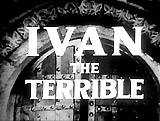

Ivan the Terrible, Part I (1945, Soviet Union) (aka Ivan Groznyy, or Иван Грозный), 100 minutes, D: Sergei M. Eisenstein
The first film in the trilogy (never completed fully) was released in the mid-1940s and hailed as a success. Followed by Part II (completed by 1946) which was suppressed and delayed until 1958 due to a ban by Stalin. Part II was titled: Ivan Groznyy. Skaz vtoroy: Boyarskiy zagovor (1958). This was the last film directed and completed by writer/director Sergei M. Eisenstein, and his technique of radical montage was substituted by costume-rich, operatic pageantry. An historical film about the idealistic and stern 16th century Ivan Vasilyevich (Nikolai Cherkasov), or Ivan IV, Duke of Moscow who ruled Russia from 1533 to 1547 as the anointed Tsar. His nickname Groznyy was usually translated as Terrible. The epic, stagey film (harkening back to highly-stylized silent film techniques) was characterized by expressionistic sets, facial closeups, heavy costuming, angled camera shots for contrast, stark light and shadows, huge sets, religious imagery and a score by Prokofiev. The film commenced with the coronation of young Grand Prince of Muscovy Ivan, by the approval of a land-owning nobility/bourgeoisie class (affluent and hereditary) known as the Boyars. He married Anastasia Romanovna (Lyudmila Tselikovskaya), the Czarina, and they had a child, infant son Dmitri. The film included his campaign against the Tartars in Kazan, Ivan's serious illness on his deathbed, battles and campaigns to reclaim lost Russian territory, and his self-imposed exile at the Alexandrov monastery before a populist movement demanded his return. The entire film was mostly about court intrigue and his struggle against the plotting of the Boyars and his efforts to make them submit to his powerful will as Tsar. He experienced major conflict with his own witchy and scheming boyarina Aunt Efrosinia Staritskaya (Serafima Birman) who plotted to assassinate him with the help of other traditionalists. She wanted to appoint her own dim-witted simpleton son Vladimir Andreyevich Staritsky (Pavel Kadochnikov) as the new Tsar. She also encouraged one of Ivan's friends, Prince Andrei Kurbsky (Mikhail Nazvanov), who lusted after Anastasia, to betray him. Another friend Fyodor Kolychev (Andrei Abrikosov) became Archbishop Philip and then became part of a religious group that opposed Ivan along with the Boyars. Ultimately, she murdered Ivan's wife by having her drink from a poisoned cup of wine. Ivan eventually consolidated power in himself through personal guards, secret police or "iron men" known as Oprichniki.


Leave Her to Heaven (1945), 111 minutes, D: John M. Stahl
Based on the best-selling novel by Ben Ames Williams. This unsettling psychological noir thriller and lush Technicolored melodrama from director John M. Stahl highlighted a menacing, father-fixated, unstable, and deranged, darkly alluring femme fatale named Ellen Berent (Gene Tierney). The 'wicked' woman was neurotically-possessive and psycho-insanely-jealous. Vincent Price portrayed her vengeful, jilted fiancee/ex-lover Russell Quinton, a newly-elected Boston-area district attorney. After proposing marriage, Ellen vowed to her deceived novelist husband Richard Harland (Cornel Wilde), who resembled her father, that she wanted him all to herself: "I'll never let you go, never, never," stopping at nothing to make the man she loved her exclusive possession. The most dramatic scene was the drowning murder of her paraplegic brother-in-law Danny (Darryl Hickman) in a Maine lake as she calmly watched from a nearby rowboat. When he became exhausted and distressed in the water from severe stomach cramps (after eating a large lunch), Ellen passively watched as he called out: "Help me!" He submerged twice and then disappeared under the surface. She pretended to assist him by diving in, but it was obviously too late. Later, Ellen deliberately fell down a flight of stairs to cause a miscarriage and kill her unborn child. And finally, she committed suicide with poison, implicating her adoptive sister Ruth Berent (Jeanne Crain) in the death (although Ruth was found innocent) and sending Richard to jail for two years for withholding evidence as an accessory to murder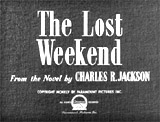


The Lost Weekend (1945), 101 minutes, D: Billy Wilder
A Best Picture-winning film - and a ground-breaking film, based on Charles Jackson's 1944 novel by co-screenwriters Charles Brackett and Billy Wilder and filmed in NYC. The Lost Weekend was a classic, melodramatic, realistically-grim and uncompromising "social-problem" film of the 1940s, about the controversial subject of alcoholism, told partially in flashback. Rather than join his brother Wick Birnam (Phillip Terry) on a weekend outing to the country, talented New York aspiring novel writer Don Birnam (Oscar-winning Ray Milland) - a chronic alcoholic with writer's block - spent a 'lost weekend' on a wild, self-destructive drinking binge. Eluding his persistently supportive girlfriend Helen St. James (Jane Wyman), he desperately trudged down Third Avenue on Yom Kippur attempting to find an open pawnshop to hock his own typewriter for another drink. In Bellevue Hospital's alcohol detoxification ward (shot on location) after a debilitating alcoholic binge, he awakened to shrieking inmates suffering the DTs, and suffered torment from sadistic male nurse 'Bim' Nolan (Frank Faylen). In his apartment, Birnam experienced hallucinations of a mouse attacked by a bat. He narrowly avoided committing suicide by shooting himself in the 'optimistic' ending. He vowed to write about his 'lost weekend' in a novel titled The Bottle.


Mildred Pierce (1945), 109 minutes, D: Michael Curtiz
One of the best melodramatic, 'women's pictures' and film noir classics of the 1940s - and Joan Crawford's comeback film. A glossy soap opera tale adapted from James M. Cain's novel. Began with the startling murder of Monte Beragon (Zachary Scott) in a beach house - by an unknown assailant. Suspect Mildred Pierce (Oscar-winning Joan Crawford) was interrogated by police for the killing of her second husband, a cad playboy. In flashback (with effective voice-over narration), housewife Mildred was divorced from her decent first husband Bert Pierce (Bruce Bennett). The hardworking, dowdy divorced mother obsessively doted on her two daughters, especially rotten, spoiled and selfish elder 16 year-old daughter Veda (Ann Blyth), so she was forced to become a waitress. Through determination and will-power, she opened up a small restaurant with the help of friend Ida (Eve Arden). She developed it into a successful and profitable chain, received financial assistance from realtor/rebuffed beau Wally Fay (Jack Carson), and married socially-prominent playboy Monte Beragon, who eventually spent her money and sent her into bankruptcy. The petulant, selfishly-ungrateful Veda, estranged from Mildred and whose greed also contributed to the restaurant's financial ruin, romanced her own step-father (a semi-incestuous relationship) behind the restaurateur's long-suffering back. The murder mystery concluded with a resolution to the question - who murdered Monte? It was revealed that insanely jealous Veda, after having her marriage proposal rejected by Monte, shot him to death. As Veda was led off, Mildred was reconciled with Bert.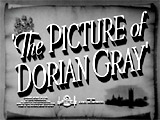


The Picture of Dorian Gray (1945), 110 minutes, D: Albert Lewin
Writer-director Albert Lewin's black and white occult-horror fantasy drama was based upon Oscar Wilde's 1891 story about a man's soul and its evil destiny. It told about the fate of healthy, handsome, and young 19th century Victorian Englishman Dorian Gray (Hurd Hatfield), an aristocrat who had his portrait painted by his friend Basil Hallward (Lowell Gilmore). Gray was distressed when reminded by cynical and witty old acquaintance Lord Henry Wotton (George Sanders) that he would not be handsome and youthful forever. He jealously spoke to the painting in the presence of a statue of the ancient Egyptian goddess Bast, that he would "sell my very soul" if he could stay young forever and never grow old. The wish appeared to come true, as the painting aged (locked away in an attic room), while Gray remained youthful. In addition to remaining good-looking, he had become hedonistic, narcissistic, ruthless, heartless, and mean in his heart, and the painting reflected his soul. He fell in love with singer Sibyl Vane (Angela Lansbury) whom he met at the Two Turtles Pub, but then rejected his fiancee, causing her to commit suicide by poison. Years later, Dorian also seized Basil's niece Gladys Hallward (Donna Reed) away from her noble suitor David Stone (Peter Lawford), but then decided at age 38 that he would leave her - he claimed it would be wicked to marry her, although she wanted to marry him. When Basil demanded to see the painting - corrupted by his secret sins - Dorian was afraid Basil would tell Gladys, and he stabbed Basil to death. The film ended with Dorian viewing his own painting - curious to see what the effects of his behavior had been upon it. There was a sudden and shocking final view of the hideously-aged painted portrait of Gray (occasionally shown in Technicolor) showing the ravages of sin and withered aging (while he remained young, vain and handsome). Dorian attempted to stab the heart of his image in the picture to release his awful visage, but he actually was stabbing his own heart. He collapsed to the floor and took on the hideous and deformed characteristics of the painting - as the painting reverted back to its original (while a swinging lamp cast ominous shadows).

Rome, Open City (1945, It.) (aka Roma, Città Aperta), 100 minutes, D: Roberto Rossellini
This war film was set at the time of Anti-Nazi Resistance in Rome during German occupation of Italy in WWII, and was often mistaken for documentary footage. Roberto Rossellini's influential, low-budget documentary-like landmark film formally introduced Italian Neo-realism - it was the first film in a Rossellini 'war trilogy' of post-war Neo-realistic films. The gritty and realistic post-war film used on-location cinematography, grainy low-grade black-and-white film stock (due to war-time), and untrained actors in improvised scenes. The film followed the plight of fugitive Resistance leader Giorgio Manfredi (Marcello Pagliero), who was eventually caught and tortured to death, after being betrayed by traitorous ex-girlfriend and prostitute Marina Mari (Maria Michi). In another of the shocking, realistic scenes, pregnant widow Pina (Anna Magnani) ran after a military truck hysterically screaming the name of her lithographer fiancee and underground leader Francesco (Francesco Grandjacquet), who was just arrested. She broke away from a soldier molesting her and ran after Francesco, when she was abruptly machine-gunned and killed the morning of her planned wedding day. Witnessing the murder was Pina's ten year-old son Marcello (Vito Annichiarico) and brave Catholic parish priest Don Pietro Pellegrini (Aldo Fabrizi), both involved in the Resistance movement. In the film's conclusion, the priest was apprehended and about to be executed by a hesitant Italian firing squad, when the German officer in charge personally decided to shoot him.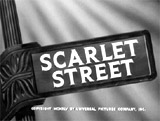


Scarlet Street (1945), 103 minutes, D: Fritz Lang
This was an early classic non-detective film noir from director Fritz Lang, a steamy and fatalistic tale - and one of the moodiest, blackest thrillers ever made. It was the tragic story of a meek, middle-aged, mild-mannered cashier and unhappily-married, hen-pecked husband Christopher Cross (Edward G. Robinson), a painter, who unwittingly fell into a cruel trap set by cold-hearted, amoral femme fatale gold-digger Katherine "Kitty" March (Joan Bennett), and her abusive, slick and mercenary boyfriend-pimp Johnny (Dan Duryea). Cross first met Kitty when she was being beaten up by Johnny on a rainy night (a set-up), and they got to know each other in a bar for a late-night drink. He was immediately entranced by the clear plastic raincoat-wearing sexy dame. The deceitful female led Cross to commit embezzlement, impersonated him in order to sell his paintings, and was cruel to him. After he proposed marriage, she told him: "Oh, you idiot! How can a man be so dumb?...I've wanted to go laugh in your face ever since I first met you. You're old and ugly and I'm sick of you. Sick, sick, sick!" She caused him in a fit of jealous anger to murder her. He stabbed her with an ice-pick through her bed covers as she hid. The film ended with Johnny being accused of the crime and executed, and Cross suffering humiliating disgrace, haunting psychological torment and mental anguish (i.e., Cross attempted suicide by hanging and failed, and in abject homelessness wandered the streets). The final image was his shuffling by a 5th Avenue gallery passing the 'self-portrait' he had drawn of Kitty, and overhearing its sale to an elderly matron for $10,000. The last lines of dialogue were heard as the haunted Cross slowly ambled down the deserted street under a movie marquee - he thought of Kitty and Johnny together, with echoing words of love spoken (off-screen) between them: Kitty: "Johnny. Oh Johnny." Johnny: "Lazy Legs." Kitty: "Jeepers, I love you, Johnny."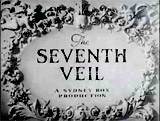




The Seventh Veil (1945, UK), 95 minutes, D: Compton Bennett
The tagline for this well-produced and acted romantic and psychological melodrama described: "Is There Always a SEVENTH VEIL Between a Woman and the Men Who Love Her?" The Muriel and Sydney Box story won the Best Original Screenplay Academy Award. It was the compelling story of teenaged Francesca Cunningham (Ann Todd), a world-famed concert pianist who had left her family. The film opened with her escape from a mental hospital, and her attempt to commit suicide with a night-time jump off a bridge. For rehabilitation and psychological treatment, she met with psychiatrist Dr. Larsen (Herbert Lom), who used hypnosis therapy to have the neurotic Francesca talk about her past, and the events and people that led her to a deep depression and mute state, and her inability to play the piano. The film, through flashback, peeled back the layers of Francesca's mentally-ill and unstable mind, composed of various veils. The removal of the last seventh veil would reveal her subconscious. She explained how as a 14 year-old orphan, she lived with her controlling and stern guardian (her second cousin), a crippled bachelor named Nicholas (James Mason), who forced her to practice piano five to six hours a day, helping her to become an excellent classical pianist. The Svengali-like Nicholas kept Francesca from other love interests, including her first musically-talented beau, American band leader Peter Gay (Hugh McDermott). After being forbidden to marry Peter, Francesca moved in with a German bohemian portrait artist-painter named Maxwell Leyden (Albert Lieven). Again, Nicholas demanded full control over her and thwarted her. He struck her hands with his cane while she was playing Beethoven’s "Pathétique" Sonata. When she fled with Max, the two had a serious automobile accident, and Francesca's hands were also burned. She was hospitalized - and the film returned to the present time. Dr. Larsen believed rightly that Francesca would be able to resume playing if she listened to a recording of Beethoven's Sonata. By the film's illogical and semi-twisted conclusion, the cured Francesca chose to remain with the demanding, dominant, and enigmatic Nicholas, the possessive mentor who had helped to nurture her to succeed in her career.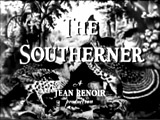

The Southerner (1945), 91 minutes, D: Jean Renoir
Based on George Sessions Perry's 1941 novel, "Hold Autumn in Your Hand," and one of the best of the five films French director Renoir made in the US, from 1941 to 1947 after he migrated to Hollywood (due to the advent of WWII). Some called Renoir's third US feature film "the first successful essay in Franco-American screen collaboration." When released, it was met with poor box-office, and in the South by boycotts and pickets from Southerners who disliked the depiction of their way of life. However, it was a critical success (Renoir was nominated for a Best Director Academy Award), and in 1946 it won the Venice Film Festival award for Best Feature Film. The visually-poetic drama, with quasi-documentary elements and sparse dialogue, told an inspiring and moving story about a poor southern tenant farmer's struggle to raise his own crops and support his family in the Deep South of southern Texas. Uneducated cotton picker field-hand Sam Tucker (Zachary Scott) decided to own and farm his own land (but without modern farm equipment) - as a sharecropper, by renting some unpromising, abandoned river-front property with meager soil that had been unfarmed from his boss/employer Ruston (Paul Harvey). Sam and his family moved into a miserable rundown shack with a dry well. His family consisted of his tough, loyal and supportive wife Nona (Betty Field), his two adolescent children Jot (Jay Gilpin) and Daisy (Jean Vanderwilt), his cranky and stubborn paternal Granny (Beulah Bondi) - and then Sam's mother Mama Tucker (Blanche Yurka). Although determined to succeed, they faced numerous trials in an endless succession of natural and man-made problems - nutritional ignorance, illness and disease (son Jot suffered from pellagra or "spring sickness"), the jealous Devers (J. Carrol Naish) - a bitter and mean neighbor and his hired hand nephew Finlay (Norman Lloyd), torrential downpours, etc. Although appearing defeated, the family continued to persevere, and the humanistic film closed on a note of optimism.



Spellbound (1945), 111 minutes, D: Alfred Hitchcock
Director Alfred Hitchcock's psychological mystery-thriller often used Freudian symbols and analysis to add richness to the mysterious plot. Intellectual and cool-minded psychiatrist Dr. Constance Petersen (Ingrid Bergman) was having a love affair with the handsome new director of the Green Manors mental hospital (or asylum), Dr. Anthony Edwardes (Gregory Peck). He had been selected to replace the outgoing director Dr. Murchison (Leo G. Carroll). As their love deepened, she began to rationally suspect that Dr. Edwardes was delusional and homicidal, and had murdered the real Dr. Edwardes. But at the same time, she was concerned that he was innocently delusional and was suffering from anxiety attacks, neurosis, paranoia, and amnesia. Hitchcock featured set-pieces to depict the crazed mental state of Edwardes - actually the imposter was named John Ballyntine (or "JB") -- there were recurring lines on a white background, including the image of parallel fork lines on the tablecloth, and sled tracks and patterns on the bedspread. These patterns were JB's partial recollection of witnessing the murder of the real Dr. Edwardes, his analyst, on a ski slope at Gabriel Valley. [Note: When the police recovered Edwardes' corpse, they discovered a bullet wound in the body's back and therefore suspected John Ballyntine of murder.] A pivotal, brilliant nightmarish dream-remembrance sequence conceived by surrealist artist Salvador Dali involved eyes on a wall, a gambling room, a blackjack (21) card game with blank cards, an angry proprietor, a sloping roof, a wheel, and a pair of pursuing wings. In one blood-chilling sequence, Ballyntine vividly remembered his young brother's accidental and tragic death by impalement on a spiked fence when he fell from a roof. In another scene, the camera focused on a straight razor carried in the hand of disturbed Ballyntine as he approached the old doctor, Dr. Murchison. By film's end, it was revealed that the murderer of Dr. Edwardes was the jealous and treacherous Dr. Murchison, who had framed imposter Ballyntine for the murder of Edwardes. Motivated by jealousy and not wanting his job stolen, Murchison had used Ballyntine's disabilities to frame him. Murchison first aimed his gun at Dr. Petersen's back after she revealed his treachery. [Note: He had given himself away when he told her: "I knew Edwardes only slightly. I never really liked him. But he was a good man, in a way, I suppose." If Murchison had known Edwardes, he shouldn't have mistaken Ballyntine for Edwardes.] Then, after she left, he slowly turned the toward the camera and fired suicidally at himself - there was a burst of red color gunflash (in the black and white film).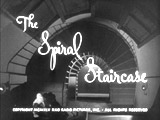




The Spiral Staircase (1945), 83 minutes, D: Robert Siodmak
A classic, old haunted house horror film with Gothic (and Hitchcockian) elements, involving a threatened female and a serial killer (who specialized in killing imperfect, physically-flawed or "afflicted" women - the film opened with the third murder by the killer, the strangulation of a crippled female). [Note: The set was the house from Orson Welles' The Magnificent Ambersons (1942).] Based on crime writer Ethel Lina White's 1933 novel "Some Must Watch." A stylish, suspenseful, and taut thriller - and psychological drama-mystery. Remade as The Spiral Staircase (1975, UK) with Jacqueline Bisset and Christopher Plummer. At the turn of the century in New England (Massachusetts), mute caretaker Helen Chapel (Dorothy McGuire) was hired to assist a wealthy, widowed, bed-ridden invalid matron Mrs. Warren (Ethel Barrymore) in a large spooky mansion - where the killer was hiding in the shadows within the house. The local bachelor doctor, Dr. Parry (Kent Smith), one of Helen's love interests, believed that her inability to speak had been trauma-induced (from a house fire that killed her parents) and was possibly reversible. Two other suitors included the widow's stepson, scholarly Professor Warren (George Brent), and her real younger son, womanizing Steven Warren (Gordon Oliver), who recently returned from living abroad. Young tormented and victimized mute Helen soon came to believe that she would be the killer's next victim. An atmosphere of terror in the old dark mansion was intensified with a raging storm outside, high contrast or light and dark shadows, a spiral staircase, the killer's menacing eyes, gusts of wind, flickering candlelights, creaking doors. By the exciting conclusion, it was implied that one of the rival stepbrothers, Steven, had murdered live-in secretary Blanche (Rhonda Fleming), but then it was revealed that Professor Warren was the killer. In the suspenseful climax set on the spiral staircase, the defenseless Helen screamed at her extreme moment of peril, and then spoke her first words since childhood with a phone call to an operator, asking for Dr. Parry: ("1-8-9...Dr. Parry...Come...It's I, Helen") - the film's final line of dialogue.

They Were Expendable (1945), 135 minutes, D: John Ford
Toward the close of the war, director Ford (after making wartime documentaries) based this realistic, old-fashioned, under-rated, inspiring and bleak (black and white) war film upon the historically-true story of the Navy's PT boat squadrons and crews based in the Philippines that were supporting the naval war in the Pacific campaign. The crews of the fast, maneuverable, lightweight plywood (not metal) PT (short for patrol torpedo) boats armed with torpedos, were there during the early years of the war (Dec 1941 - April 1942) and faced the greatly-outnumbered advance of Japanese forces immediately after the bombing of Pearl Harbor. The straight-forward, well-directed, semi-patriotic film, a detailed and authentic-looking action-war drama, was based on William L. White's bestselling 1942 book with the same title about torpedo boat squadron commander Lt. John Brickley (real-life Congressional Medal of Honor winner John Bulkeley) (Robert Montgomery) and his second-in-command executive officer, PT boat officer/skipper Lt. J.G. "Rusty" Ryan (real-life Robert Kelly) (John Wayne). A hospitalized Ryan had moments of on-screen romance with nurse Lt. Sandy Davyss (Donna Reed) when he was in sick bay.


A Tree Grows in Brooklyn (1945), 128 minutes, D: Elia Kazan
This sincere, endearing and moving family drama and coming-of-age tale marked Elia Kazan's directorial debut. It was based on Betty Smith's beloved 1943 novel with the same name, about a turn-of-the-century Brooklyn family of Irish members, the Nolans, who were struggling to survive in their challenging tenement neighborhood-environment. In one scene set at their apartment window, improvident Irish singing waiter Johnny Nolan (Oscar-winning James Dunn) told his bright young 13 year-old daughter Francie Nolan (Special Oscar-winning Peggy Ann Garner), an aspiring writer, that she needn't worry that the neighbors killed a courtyard tree nearby, with an optimistic tone: "They didn't kill it, why they could cut that old tree right down to the ground and a root would push up someplace else in the cement. You wait until springtime, my darlin', you'll see." He was encouraging, comparing their family's (and his own) struggles to the resilient tree in their tenement area. The down-to-earth, frugal, strong-willed, hard-working and firm mother Katie Nolan (Dorothy McGuire) was the backbone and strength of the family, and was appropriately hard on Johnny, although her treatment of him was misunderstood by Francie. Johnny was a ne'er-do-well loser, due to his frequent drinking and irresponsible nature, but he was still kind, loving and encouraging. He sat with dreamer Francie at her bedside at Christmastime, and encouraged her aspirations to grow up and be a writer. In a heartbreaking scene, he watched her fall asleep, faced the truth and decided to go out and find a real job (to support his now-pregnant wife, and to keep Francie in school) - and never came home again. He died from pneumonia - exposure to the elements while job-searching.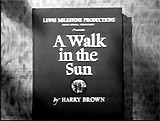


A Walk in the Sun (1945), 117 minutes, D: Lewis Milestone
Director Lewis Milestone's modest yet starkly realistic, dialogue-filled, unglamorized combat film was based upon the novel by Yank Magazine's Harry Brown. This was Milestone's second (and middle) film in a war trilogy, composed of All Quiet on the Western Front (1930), and Pork Chop Hill (1959). It is often considered one of the best WWII war-battle films ever made, although it was essentially bloodless. It thoughtfully portrayed the psychological stress felt by the US GIs. It intimately followed an American infantry unit in 1943, led by platoon squad leader Sgt. Bill Tyne (Dana Andrews), that was struggling to survive during a combat mission. They were making a frontal assault on a fortified, Nazi-occupied farmhouse in Italy, as part of the Allied attack on Anzio. The tension and fear was brilliantly captured on the faces of the terrified soldiers as they took the short, six-mile journey (from the coastal beach at Salerno, moving inland through the Italian countryside) to the farmhouse where they were on a mission to blow up a bridge. Despite heavy losses and fearful madness, the bridge was destroyed and the platoon triumphantly captured the fortified farmhouse.